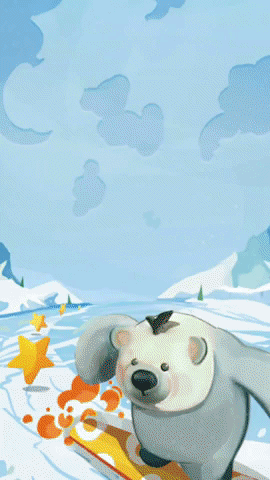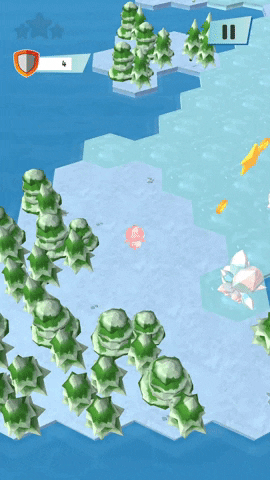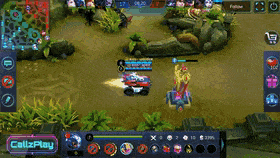

Icy Drift is a mobile hypercasual game made from a game submitted for a game jam hosted by the Japanese entertainment company Bushiroad.
Though my team did not win the game jam, Bushiroad's Asian branch's Director Daisuke favored the concept and offered my team a spot in their company as interns. We were given 3 months to make a hypercasual game.
Platform: Android/IOS Players: 1 Genre: Hypercasual, Top-Down runner
Downloads: IOS /Google Playstore
Role:
Mechanics/Level designer
-Overview -
- Gameplay -

You play a wandering character trying to get to the goal at the end of each map by walking on land and sliding on ice. While doing so, avoid obstacles and falling in the water. Controls are as simple as just using your thumb to control the on-screen joystick and swerve the character around in order to move it.
A secondary goal is to collect the coins and stars to have a chance to roll and get new items such as characters and boards.
You can also double-tap the screen to activate a shield if you have it. Shields help prevent death from obstacles such as ice pillars and penguins.

- Inspiration -
My role during the game jam was to inspire my team to make a game in 2 days with the theme of "endless". Thus, inspired by the popular mobile MOBA game Mobile Legends, I adapted one of the hero's ultimate as gameplay for the game jam.

The gameplay is actually really simple in that the player has limited controls as they are forced to move forward. Like in the MOBA, the longer a player plays the hero's ultimate, the more masterful they get in landing game-winning crashes. Although, in my game, the player would do the opposite of crashing.
-Planning -
Icy Drift was originally called "Just Ice" in the game jam as the idea was the player would see just ice as they traverse endlessly. Bringing forward the game to Bushiroad, we opted to have an endless game mode as well as levels to follow the trends of hypercasual games like Candy Crush.
We also explored various obstacles that increase as the players progress. In the end, we proposed 160 levels for the launch of the game, and while the programmers are preparing the base prototype, I started crafting the levels on "paper".




To make it easily tillable for the tile generator, I used hexagons as they promote unique shapes as compared to squares.
In the beginning, we thought of having specific hexagon tiles that close up the edges but it was ultimately scrapped to make the levels faster. Some of the level design was also scrapped due to the difficulty after much testing
To add to the swerving mechanics, I played around with different surfaces and obstacles that I suggested to the gameplay programmers. Each suggestion I made for the obstacles are tested with the team before exploring making the bulk of the levels.
As a method of retaining players, the game has cosmetics that can be unlocked via coins on each level to denote completion as well as 3 stars to collect in levels for completionists.
The table below shows the first time the player encounters the ice types/encounters.

-Execution -

As I have to churn out and test 160 levels, I get the help of the programmers to build some levels once they are done with their work. Having a plan and "rules" help in guiding them on how to build each level to challenge the players while not being too overbearing and difficult.
Thus, for each new tile type and obstacle added in, I make up simple do's and don'ts when explaining to them how to create the levels. Simple notes for the level designer to build his levels while I am busy with other work. I would also build test levels to show how the tiles are placed typically so they can reference them.

The most important tile is the Goal Tile which lets the player complete the level. It may be trivial to forget this tile but with over a hundred levels made in a short time span, the designer could forget to place it and submit the level. As a rule of habit, I made premade levels that include these sets of tiles so that the level designer won't forget.

Each green tile will also be accompanied by ground tiles as a standard so players can gain their footing before heading over to the next stage.
The basic Ice Tile introduces the player to the standard in traversing throughout the level. The rule for this tile is to have at least 2 tiles of space for traversal and never do a single line to keep the difficulty a standard. This rule goes to other advanced tiles too.


For the earlier levels, ground tiles are placed in between long segments for players to rest. In later levels, ground tiles may be used to hold enemies and collectibles. As the game has no time limit, players are encouraged to rest on these tiles and plan their next sliding route.

The rest of the ice types provide players with advanced challenges and tests on what they have learned so far from the previous levels. In terms of level design, each tile type has rules to make sure no problems arise when playtesting.

The "Fast Ice" tile, as the name suggests, slides the players faster than normal tiles. On the earlier levels, I usually will place some ground tiles on the ends of fast tiles so players can stop and assess their routes. a rule of thumb for fast ice would be to only use it to make "roads" and not "areas" as players will have no time to react going in circles.
"Breakable Ice" shatters underneath the player's feet after they slide past it. It has the same friction as regular tiles so players have time to react and realize the tiles are breaking. These tiles won't regenerate so it is best to plan ahead before you get stuck. Earlier levels will have alternative fast tile routes while harder levels have more ground tiles before an area of breakable ice tiles.


"Dark Ice" is unique in that the player has no swerving control when they enter the tile. This "Ultra Slippery" tile has the same speed as regular tiles but whatever orientation the player is facing will be its destination. Thus, players have to aim correctly and plan ahead to the safer tile as a few wrong rotations might lead to deathly waters.
"Fan tiles" lifts players over bodies of water and they also have some control of where they are flying. As the last unique tile introduced to the level pool, these tiles add depth to the levels as players can traverse above the water. One way to utilize this tile is to force players to fly to an area where they cannot return as there are no fan tiles in that new area.

END
View my other works:

